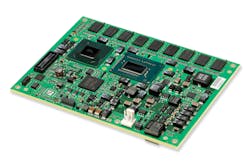To many outside the systems design realm, embedded computing devices in automation equipment are shrouded in mystery. Few people fully understand what these devices do and even fewer base their automation selection decisions around consideration of these devices.
But that may be about to change.
Over the next year, there will be a number of new announcements on the embedded computing front that will impact how automation equipment is designed and what it is capable of doing. Stay tuned to find out more, as I’ll keep you updated as soon as I have releasable information.
In the meantime, take note of the recent release by GE of its rugged bCOM6-L1400 COM Express module. According to GE, this module employs the processing and graphics capabilities of the recently announced Intel Core i7 processor to support multiple independent displays in industrial applications across a range of embedded computing environments.
To help make sense of how this module differs from other such processors, it’s important to know that, by separating the carrier card from the processor, the COM Express architecture is able to extend the life of the subsystem by allowing for the processor alone to be upgraded while keeping the rest of the system in place. GE says that this reduces long-term cost of ownership while ensuring that performance keeps pace with the changing needs of the user.
The new module also complements GE Intelligent Platforms’ portfolio of rugged embedded computing solutions that includes single board computers, multiprocessors, Ethernet switches, displays and networking.
GE says the bCOM6-L1400 can be deployed in the harshest environments that are subject to extremes of temperature, vibration, shock and contaminants.
Leaders relevant to this article:


